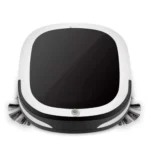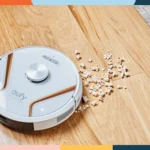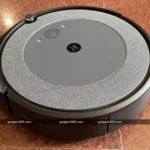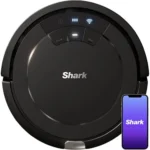Imagine coming home from work to find your floors impeccably clean, without ever having to lift a finger or push a clunky vacuum cleaner around. Thanks to the advent of smart vacuum cleaners, this dream is now a reality. These innovative devices integrate artificial intelligence (AI) to perform tasks that were once reserved for humans, providing a high level of efficiency and convenience for the user. But how exactly does AI work in smart vacuum cleaners? And what benefits does it offer that traditional vacuum cleaners cannot? In this article, we will explore the role of AI in smart vacuum cleaners and its impact on the cleaning industry.
The Basics of Smart Vacuum Cleaners
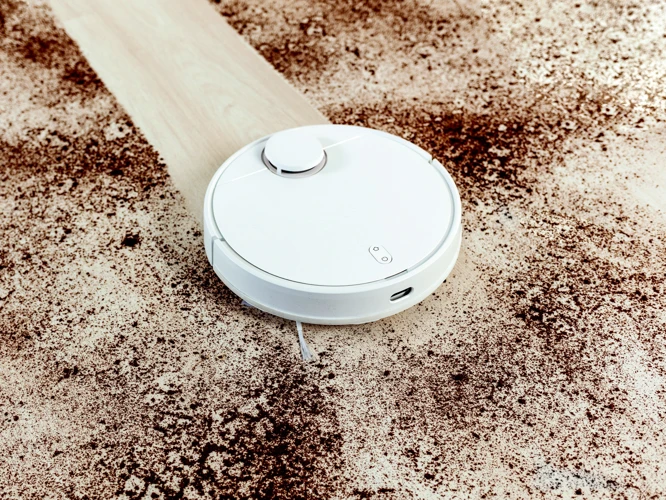
Smart vacuum cleaners have revolutionized the way we clean our homes. These intelligent devices have come a long way since their inception, offering advanced features that make cleaning more efficient and effortless than ever before. In this section, we will explore the basic components and functions of smart vacuum cleaners, including their sensors, navigation systems, and cleaning modes. We’ll also discuss the significance of WiFi connectivity and room mapping capabilities in these devices. We’ll examine how smart vacuum cleaners have become an integral part of the smart home ecosystem. So let’s dive into the amazing world of smart vacuum cleaners!
What is a Smart Vacuum Cleaner?
A smart vacuum cleaner is a type of robotic vacuum cleaner that uses built-in sensors, processors, and artificial intelligence (AI) algorithms to navigate around the room and clean the floors efficiently. Unlike traditional vacuum cleaners that require manual operation, smart vacuum cleaners are designed to work autonomously with little or no input from the user.
One of the key features of a smart vacuum cleaner is its ability to map the layout of the room and create a digital map using its sophisticated sensors and mapping capabilities. This allows the device to navigate around the room intelligently and clean the floors methodically without missing any spots.
Smart vacuum cleaners also come equipped with a range of cleaning modes that can be tailored to different surfaces and cleaning needs. For example, some models have a spot cleaning mode that is designed to tackle specific areas of the room that require extra attention, while others have a deep cleaning mode that provides a thorough clean.
In addition to the above features, modern smart vacuum cleaners can also detect and avoid obstacles using their advanced sensors and obstacle detection capabilities. This enables the devices to navigate around furniture, rugs, and other objects with ease, without getting stuck or causing damage.
Another important feature of smart vacuum cleaners is their connectivity to Wi-Fi networks and smart home devices. This allows users to control the device using voice commands or a smartphone app, set schedules for cleaning, and receive real-time notifications about the cleaning progress.
Smart vacuum cleaners offer a range of features and capabilities that make them a popular choice for consumers who want a convenient and efficient way to keep their floors clean. From advanced sensors and mapping capabilities to real-time monitoring and control, these devices are paving the way for a future where cleaning is automated and hassle-free.
The Benefits of Smart Vacuum Cleaners
Smart vacuum cleaners, also known as robotic vacuum cleaners, are revolutionizing the way we clean our homes. With the advancement of technology, these devices are becoming more sophisticated, providing numerous benefits to users. Let’s take a look at some of the benefits of using a smart vacuum cleaner:
| Benefits of Smart Vacuum Cleaners |
|---|
| Convenience: One of the biggest benefits of smart vacuum cleaners is convenience. These devices work autonomously and can be scheduled to clean at specific times, which means they clean even when you’re not around. This allows for more free time and less time spent cleaning. Room mapping technology and cleaning modes also contribute to the convenience factor by allowing you to customize cleaning for your specific needs. |
| Efficiency: Smart vacuum cleaners are designed with advanced technology, such as smart navigation systems and obstacle detection sensors, which make them highly efficient cleaners. These features allow the machines to navigate through your home and avoid collisions with obstacles, all while capturing dirt and dust. |
| Time and Energy Saver: Smart vacuum cleaners not only save time, but also save energy. Since they are able to clean floors on their own, the user does not have to put in any extra effort. This is beneficial for those who may have limited mobility or have trouble devoting the necessary time and energy to cleaning. |
| Improved Air Quality: Smart vacuum cleaners are equipped with high-efficiency filters that capture even the smallest particles of dirt, dust, and allergens. This is especially beneficial for individuals who have allergies or respiratory problems. By eliminating these particles from the air, these devices help to improve the overall air quality of your home. |
| Connectivity: Many smart vacuum cleaners are equipped with Wi-Fi connectivity which allows for control via smartphone apps. This feature also brings additional benefits such as remote start/stop or scheduling cleaning from anywhere, making it possible for the user to have a tidy home at any time with just a few taps on their smartphone. |
With all these benefits, it’s not surprising that smart vacuum cleaners are rapidly gaining popularity. Not only do they make cleaning easier and more convenient, but they also contribute to a cleaner and healthier home environment.
How Does AI Work in Smart Vacuum Cleaners?
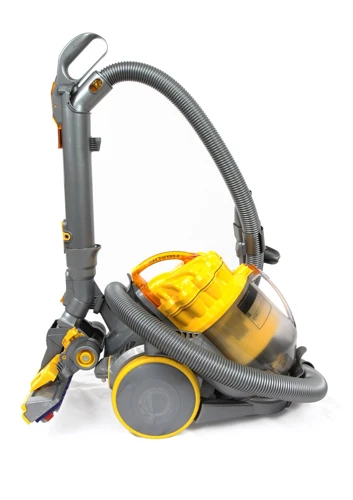
As technology advances, so does the functionality of household appliances. Smart vacuum cleaners are gaining popularity, thanks to the integration of Artificial Intelligence (AI) in their features. AI-powered smart vacuum cleaners come with advanced sensors, mapping and location capabilities and real-time monitoring, among others. But how does AI work in smart vacuum cleaners to make them more efficient and effective? Let’s delve deep into the role of AI in smart vacuum cleaners, exploring the advanced sensors, machine learning capabilities, and more. We’ll also cover the basics of smart vacuum cleaners, the benefits they offer and how they differ from traditional vacuum cleaners.
Advanced Sensors and Mapping Capabilities
Smart vacuum cleaners are equipped with advanced sensors and mapping capabilities that make them efficient and convenient tools for cleaning different areas of a home. Through the use of intelligent sensors, these devices are able to detect and avoid obstacles, navigate around furniture, and optimize their cleaning routes, which results in a more thorough cleaning job.
One of the most important sensors in a smart vacuum cleaner is the floor sensor. This sensor can detect different types of surfaces and adjust the cleaning power accordingly. For example, when the device detects a carpet, it will increase the suction power to clean the carpet more deeply. When it senses hardwood floors, it will decrease the suction power to avoid damaging the surface.
Another important sensor is the cliff sensor. This sensor detects edges such as stairs, and prevents the vacuum cleaner from falling off and getting damaged. Additionally, it’s worth mentioning the presence of obstacle sensors, which detect furniture and other obstacles present in a room, so the vacuum can avoid them by changing its direction.
But sensors are just one component of the advanced mapping capabilities of smart vacuum cleaners. These devices also come equipped with lasers, cameras, or a combination of both, to map their surroundings in real-time. This allows them to create a detailed map of the home, and effectively navigate around furniture, wall corners, and other difficult to reach areas.
Mapping capabilities allow the vacuum cleaner to remember the areas it has already cleaned, so it can avoid cleaning the same area twice, and focus on areas that need it the most. This ultimately leads to a more efficient cleaning process and saves energy, time, and battery life.
The advanced sensors and mapping capabilities in smart vacuum cleaners represent a major technological breakthrough in home cleaning. These features ensure thorough cleaning, efficient use of resources, and greater convenience for users. With the rapid advancements in AI and robotics, we can expect even more advanced features in future generations of smart vacuum cleaners. If you want to know more about sensors in vacuum cleaners, please read our guide on sensors in vacuum cleaners.
Real-Time Monitoring and Control
Real-time monitoring and control is one of the key aspects of AI in smart vacuum cleaners. The ability to monitor and control the cleaning process in real-time allows for greater efficiency and effectiveness in cleaning. Let’s take a closer look at how this works.
Sensor Technology
Smart vacuum cleaners are equipped with various sensors that allow them to perceive their environment in real-time. For example, many smart vacuum cleaners have sensors that can detect obstacles, such as furniture or walls, and adjust their cleaning accordingly. Many smart vacuum cleaners have sensors that can detect changes in floor type, such as carpet or hardwood, and adjust their cleaning settings for optimal performance.
Remote Control
Many smart vacuum cleaners come with a remote control that allows users to monitor and control the cleaning process in real-time. Users can easily adjust settings, such as cleaning mode, suction power, and cleaning schedule, from the comfort of their own couch. Some smart vacuum cleaners even come with mobile apps that allow users to control and monitor the cleaning process from their smartphones.
Voice Control
Another advanced feature of AI in smart vacuum cleaners is voice control. Some smart vacuum cleaners can be controlled using voice commands, allowing for hands-free operation. This is especially useful for individuals with mobility difficulties or busy schedules.
Data Analysis
AI in smart vacuum cleaners also allows for real-time data analysis, which can help users optimize cleaning performance. For example, smart vacuum cleaners can monitor cleaning patterns and adjust their algorithms for more efficient cleaning. Smart vacuum cleaners can analyze data on cleaning coverage and suggest areas that may need extra attention.
Real-time monitoring and control is an important aspect of AI in smart vacuum cleaners, which allows for greater efficiency, effectiveness, and convenience in cleaning.
| Benefits of Real-Time Monitoring and Control | Examples |
|---|---|
| Efficient cleaning | Adjusting suction power and cleaning mode in real-time based on floor type |
| Convenient operation | Controlling and monitoring the cleaning process from a remote control or mobile app |
| Hands-free operation | Voice control for individuals with mobility difficulties or busy schedules |
| Optimized cleaning performance | Data analysis on cleaning patterns and coverage for more efficient cleaning |
Machine Learning and Predictive Maintenance
Smart vacuum cleaners are equipped with advanced AI technologies such as machine learning and predictive maintenance, which allow them to learn and adapt to their environment. Machine learning involves using algorithms to analyze patterns and data to make predictions or decisions without being explicitly programmed.
One application of machine learning in smart vacuum cleaners is predicting when the device needs maintenance or repairs. The device can analyze data, including the amount of dirt and debris collected, the frequency of usage, and the cleaning results, to determine the likelihood of a breakdown or replacement of certain parts. This information can be used to schedule preventative maintenance, reducing the risk of expensive repairs or downtime.
Another benefit of using machine learning in smart vacuum cleaners is the ability to improve cleaning performance. The device can learn from user behavior and adjust its cleaning patterns accordingly. For example, if the device detects that certain areas of the house are more frequently used, it can adjust its cleaning schedule to prioritize those areas.
Machine learning can also aid in mapping and navigation. By analyzing data from sensors and cameras, the smart vacuum cleaner can learn the layout of the house and optimize its cleaning path to cover all areas. It can also learn to avoid obstacles such as furniture or pets, making the cleaning process more efficient.
The following table summarizes the benefits of using machine learning and predictive maintenance in smart vacuum cleaners:
| Benefits of Machine Learning and Predictive Maintenance in Smart Vacuum Cleaners |
|---|
| Ability to predict maintenance and repairs, reducing downtime and costs |
| Improved cleaning performance through learning and adapting to user behavior |
| Optimized mapping and navigation, improving cleaning efficiency |
Using machine learning and predictive maintenance in smart vacuum cleaners not only improves overall cleaning efficiency and performance, but also reduces maintenance and repair costs, making these devices a worthwhile investment for any modern household.
The Advantages of AI in Smart Vacuum Cleaners
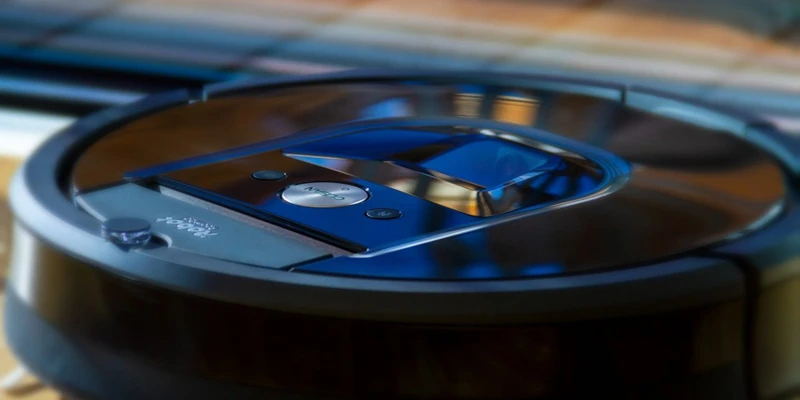
As smart vacuum cleaners continue to gain popularity, the role of artificial intelligence (AI) in these devices is becoming increasingly important. The use of AI in smart vacuums provides some incredible benefits that traditional vacuum cleaners simply cannot match. In this section, we will explore the advantages of AI in smart vacuum cleaners, highlighting the various ways in which AI technology is revolutionizing the way we clean our homes. From enhanced efficiency and performance to improved user experience, the advantages of AI in smart vacuum cleaners are numerous and significant. Let’s dive in and discover why AI is essential for the future of cleaning technology.
Higher Levels of Efficiency and Performance
Smart vacuum cleaners equipped with AI technology boast significantly higher levels of efficiency and performance compared to their traditional counterparts. Here are some of the ways in which AI contributes to the enhanced efficiency and performance of smart vacuums:
- Customized Cleaning Plans: AI technology allows smart vacuum cleaners to analyze the layout, size, and shape of the room and come up with a customized cleaning plan that efficiently covers every inch of the floor.
- Intelligent Navigation: By utilizing advanced sensors and mapping capabilities, smart vacuums can navigate a room more intelligently, avoiding obstacles and redirecting to previously uncleaned areas to ensure maximum coverage. They are also able to detect and avoid stairs or other drop-offs, preventing damage to the device.
- Predictive Maintenance: One of the biggest advantages of AI in smart vacuums is that it can predict maintenance needs such as when filters need to be cleaned or replaced, ensuring that the device continues to operate at optimal efficiency without interruption.
- Real-Time Monitoring: With AI-enabled sensors, smart vacuums constantly monitor their surroundings and can adjust their cleaning patterns based on the level of dirt or debris in any given area. This feature ensures that the device is always working at its optimal performance, picking up as much dirt and debris as possible.
As AI technology in smart vacuum cleaners continues to advance, we can expect to see even more impressive levels of efficiency and performance. From customizing cleaning plans to predictive maintenance and intelligent navigation, these devices are changing the way we think about household cleaning needs. The benefits of AI in smart vacuums extend beyond just efficiency and performance, with reduced maintenance and repair costs, as well as improved user experience also being key advantages.
Reduced Maintenance and Repair Costs
One of the major advantages of AI in smart vacuum cleaners is the significant reduction in maintenance and repair costs. This is achieved through a range of sophisticated features that minimize wear and tear on the device, as well as identifying and addressing issues before they become more serious.
Here are some of the key ways that AI can reduce maintenance and repair costs:
- Predictive maintenance: With AI, smart vacuum cleaners can identify potential problems before they result in serious malfunctions. This allows for proactive maintenance and repair, reducing downtime and repair costs.
- Real-time monitoring: AI-powered sensors can detect changes in the device’s performance, such as decreases in suction power, and make adjustments to prevent further damage.
- Schedule optimization: AI can optimize cleaning schedules and patterns, minimizing wear and tear on the device and extending its lifespan. This reduces the need for repairs and replacement parts.
- Self-diagnosis: Smart vacuum cleaners equipped with AI can diagnose issues in real-time and provide users with detailed error messages. This allows for quicker and more accurate repairs, saving time and money.
- Remote troubleshooting: For complex issues, AI can enable remote troubleshooting and even remote repairs. This minimizes the need for technician visits and associated costs.
By reducing the need for repairs and maintenance, smart vacuum cleaners powered by AI can offer significant cost savings over traditional devices. This is a major benefit for both homeowners and commercial cleaning companies alike, making smart vacuum cleaners a valuable investment for the long-term.
Improved User Experience
Smart vacuum cleaners with AI have revolutionized the cleaning process by providing efficient and convenient cleaning. One of the significant advantages of AI in smart vacuum cleaners is an improved user experience.
With AI-enabled features, smart vacuums ensure that users have an easy time operating and controlling the vacuum while cleaning. The advancements in sensors and mapping capabilities enable the vacuum to maneuver around the house while avoiding obstacles and detecting areas that require more cleaning. This means that users will not have to worry about supervising the vacuum, letting them focus on other essential activities.
AI in smart vacuum cleaners enhances the precision of cleaning by recognizing flooring surfaces, adjusting suction power, and adapting to different floor types. Whether it’s a hardwood floor or a carpet, a smart vacuum cleaner with AI can efficiently clean efficiently, saving users time and effort.
Another aspect of user experience that AI in smart vacuum cleaners has improved is the interaction between the vacuum and its users. With the presence of voice assistants, users can control the vacuum cleaner from their smartphone or smartwatch, allowing them to schedule cleanings, turn the device on or off, and request cleaning progress updates.
Smart vacuum cleaners with AI have introduced remote control to user experience. Users can remotely monitor and control the vacuum even when they are not at home, ensuring that they can have a clean house at all times. This feature is especially useful for pet owners who need to ensure that pet hair and dander does not accumulate in their absence.
The integration of AI technology in smart vacuum cleaners has significantly improved the user experience. The convenience and precision of cleaning, as well as the ease of controlling and monitoring the vacuum, enable users to focus on other important tasks while still ensuring their house remains clean.
| Advantages | Description |
|---|---|
| Efficient Cleaning | AI recognizes flooring surfaces, adjusts suction power, and adapts to different floor types hence providing efficient cleaning. |
| Voice Control Assistant | Users can control the vacuum cleaner from their smartphone or smartwatch, allowing them to schedule cleanings, turn the device on or off, and request cleaning progress updates. |
| Remote Control | Users can remotely monitor and control the vacuum even when they are not at home, ensuring that they can have a clean house at all times. |
The Future of Smart Vacuum Cleaners
As technology continues to advance, so does the potential for innovation in the world of smart vacuum cleaners. The possibilities for the future of these devices are endless, and it’s exciting to imagine what’s in store. From advancements in AI and robotics to integration with other smart home devices, the future of smart vacuum cleaners looks promising, and there’s no doubt that these devices will continue to evolve and improve. Let’s take a closer look at what we can expect in the exciting times ahead.
Integration with Other Smart Home Devices
As smart home technology continues to advance, we can expect to see further integration between smart vacuum cleaners and other smart devices in the home. This will allow for a more seamless and integrated home cleaning experience.
One potential area of integration is with smart speakers. Users could simply command their smart speaker to start the vacuum cleaner, without having to physically interact with the device. This would offer a whole new level of convenience and ease of use.
Another potential integration could be with smart thermostats. By using the vacuum cleaner’s sensors, the thermostat could detect when the home is clean and adjust the temperature accordingly, saving energy and reducing utility costs.
Additionally, with the rise of smart locks and security systems, we could see integration between smart vacuum cleaners and home security systems. For example, the vacuum cleaner could be programmed to automatically clean the home when the security system is activated, ensuring that the home is clean and tidy before the owner returns.
Finally, we may also see integration between smart refrigerators and vacuum cleaners. Vacuum cleaners could be programmed to clean up any spills or messes around the refrigerator area, ensuring that the kitchen stays clean and sanitary.
As these devices become more advanced and interconnected, we can expect to see a well-coordinated and efficient cleaning experience that is highly integrated with the rest of the smart home.
| Smart Devices | Potential Integration with Smart Vacuum Cleaners |
|---|---|
| Smart Speakers | Voice-activated commands to start the vacuum cleaner |
| Smart Thermostats | Adjusts temperature based on vacuum cleaner’s sensors usage |
| Smart Locks and Security Systems | Vacuum cleaner automatically cleans the home when security system is activated |
| Smart Refrigerators | Vacuum cleaner cleans up spills or messes around the refrigerator area |
Integration between smart vacuum cleaners and other smart devices in the home is a trend that is likely to continue in the future. These developments will lead to a more coordinated and efficient cleaning experience, while also providing greater convenience and ease of use for homeowners.
Further Advancements in AI and Robotics
Looking towards the future, there is no doubt that advancements in AI and robotics will continue to revolutionize the smart vacuum cleaning industry. Here are some of the potential developments we may see in the coming years:
| Advancements in AI | Advancements in Robotics |
|---|---|
|
|
As these technologies continue to evolve, we can expect smart vacuums to become even more powerful, efficient, and user-friendly. With these tools at their disposal, homeowners will be able to spend less time cleaning and more time enjoying their homes. From object recognition to improved battery life and beyond, the possibilities for future advancements are limited only by our imaginations.
Conclusion
In conclusion, the integration of Artificial Intelligence in smart vacuum cleaners has revolutionized the way people clean their homes. Smart vacuum cleaners have made cleaning easier and more efficient by utilizing advanced sensors and mapping capabilities, real-time monitoring and control, and machine learning and predictive maintenance.
Through the use of AI, smart vacuum cleaners can map out the layout of the room and optimize their cleaning patterns. They can also detect and avoid obstacles, which means they can clean with minimal human intervention. This not only saves time but also reduces human error.
In addition, AI-powered smart vacuum cleaners can monitor their performance in real-time and adjust their settings as needed, resulting in more efficient cleaning. This means that users can expect a higher level of performance and efficiency from their smart vacuum cleaners.
Furthermore, the use of AI in smart vacuum cleaners reduces maintenance and repair costs. The sensors and monitoring capabilities of these devices means that potential problems can be detected early, and preventative maintenance applied. This prolongs the life-span of the device and saves homeowners the cost of repairs.
As the use of AI in smart vacuum cleaners continues to advance, we can expect even more benefits in the future. Integration with other smart home devices will mean that cleaning can be seamlessly integrated with other aspects of home management. Further advancements in AI and robotics will continue to enhance performance and efficiency.
Overall, the advantages of AI in smart vacuum cleaners are clear. Improved efficiency and performance, reduced maintenance and repair costs, and an enhanced user experience all make AI-powered smart vacuum cleaners an excellent addition to any household.
Frequently Asked Questions
What is the difference between a regular vacuum cleaner and a smart vacuum cleaner?
A regular vacuum cleaner requires manual control, while a smart vacuum cleaner can be programmed and controlled remotely using AI technology.
What kind of sensors do smart vacuum cleaners use?
Smart vacuum cleaners use a variety of sensors including infrared, ultrasonic, and cliff detection sensors to navigate and avoid obstacles.
How accurate are the mapping capabilities of smart vacuum cleaners?
The mapping capabilities of smart vacuum cleaners are highly accurate, as they use advanced sensors and algorithms to create a detailed map of the home as they clean.
Do smart vacuum cleaners recognize furniture and other obstacles?
Yes, smart vacuum cleaners can recognize furniture and other obstacles using infrared sensors and other technologies.\
Can smart vacuum cleaners be controlled with a smartphone app?
Yes, most smart vacuum cleaners can be controlled using a smartphone app that allows for remote programming and control.
How does machine learning help smart vacuum cleaners adapt to their environment?
Machine learning algorithms allow smart vacuum cleaners to learn from past cleaning experiences, enabling them to adapt to their environment and improve their performance over time.
Are there any privacy concerns with using a smart vacuum cleaner?
While smart vacuum cleaners do collect and store data about your home, most models have strong privacy and security protections in place to safeguard user information.
Can smart vacuum cleaners work on both carpets and hard floors?
Yes, most smart vacuum cleaners are designed to work on both carpets and hard floors, using different modes and settings to adapt to different types of surfaces.
How long does it take for a smart vacuum cleaner to charge?
The charging time for a smart vacuum cleaner varies based on the model, but most take between 2-4 hours to fully charge.
What is the expected lifespan of a smart vacuum cleaner?
The lifespan of a smart vacuum cleaner depend on the brand and model, but most have a lifespan of 3-5 years with proper maintenance and care.

